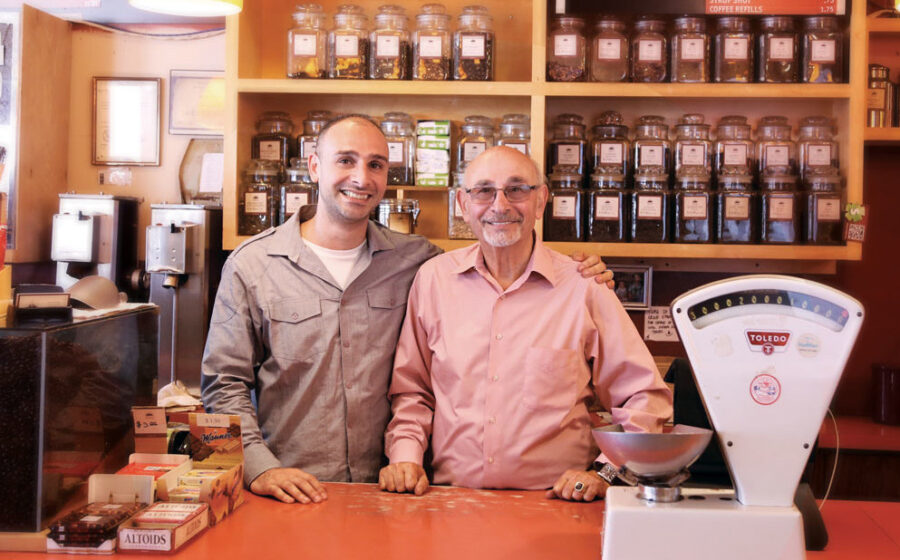[O]n a sunny Saturday in Seattle, SCAA’s 2014 Event thrummed with energy. Henry and Hrag Kalebjian of Henry’s House of Coffee walked the gargantuan exhibitor floor side-by-side, charming fellow attendees with their genuine enthusiasm and amusing father-son banter.
The Kalebjian team flew up for the expo from their single-shop micro-roastery in San Francisco. House of Coffee is small, but with a legacy dating back to the sixties, it’s one of the city’s first specialty coffee companies. As they strolled through the country’s largest coffee conference, Henry and Hrag looked to the future. Passing booths serving exquisite single-origin coffees, Hrag nudged his dad to try some less familiar roasts.
“Taste some of these Yirgacheffes,” he said with excitement. “They taste like blueberries.” Henry, a veteran roaster with close to a lifetime in coffee, a craft he inherited from his father, obliged. The nuances of the light-roasted beans wowed and surprised him.
The following Monday morning, in San Francisco’s Sunset district, Henry awoke just after dawn and quickly began roasting a recent shipment of green beans. It was somewhat early to start work on the days coffee quota. When Hrag questioned his father’s urgency, Henry responded, “I’m going to try this bean a little lighter.”
“But it’s seven a.m.,” said Hrag, dumbfounded.
“I can’t sleep,” said Henry. “I want to roast. I have ideas.”
To those who know him well, Henry’s motivation to begin experimenting is true to form. The seventy-one-year-old owner and roaster possesses a devotion to the bean that is palpable. Customers entering House of Coffee are greeted by an increasingly rare sight in boutique roasting: Henry works a twelve kilogram San Franciscan roaster in full view of patrons, measuring mainly by sight and touch the progress of each batch, all while hailing regulars as they stop in. His roasting philosophy is characterized by a tactile prowess garnered from decades in coffee (there are no computerized helpers here) and total transparency.
“I got to the point where I was like, ‘Am I going to be the guy that kills this lineage of coffee roasting?’” says Hrag.
Area roasters from newer coffee companies (San Francisco has many) stop in from time to time, covertly eyeing the grandfather business and Henry’s process. But Henry calmly stays on task, because if he doesn’t, a customer, a friend, might go without.

Today Henry is teaching his son to roast, while Hrag uses a degree in business and a background in finance to update some of the shop’s more outdated practices. It’s clear when speaking to both that bringing in the new has not always been easy. The recent addition of a daily dairy order form, for example, was a simple switch to allow Henry to delegate the task that did not go over smoothly.
“At first I was confused, I thought, ‘Does he not like it? Does he think it’s dumb?’” says Hrag earnestly. Then it dawned on him why his father was resistant to the change. “He liked ordering milk!” Hrag laughs, adding that the last year has brought him and his father much closer.
Initially resistant to the family business, it was while at AAA that Hrag began to ponder the person-to-person connections in business. He thought back to his observations as a child of his father’s interactions with customers. Remembering Henry’s dedication to their happiness, and passion for his trade, a light went on.
“I got to the point where I was like, ‘Am I going to be the guy that kills this lineage of coffee roasting?’” says Hrag.
The newest branch of that lineage should take comfort that it’s been defined by change. Hrag’s grandfather, Henry’s father, was a baker and coffee roaster in Lebanon. An Armenian immigrant, Henry’s father taught him to roast in a style typically old world, where tending a fire and hand-cranking a drum were integral to the process.
By the age of twelve Henry had left school to roast for his father’s pastry business. When he moved to San Francisco in the early seventies, he brought that early experience to a more modern roasting process at House of Coffee. In the eighties, as fresh coffee and in particular to-go coffee became more popular, walls once occupied by barrels of grains, bread, dried fruits, olive oils, and sea salts were taken over by bags of different signature roasts. The café moved from Irving Street to its current location on Noriega Street, and Henry worked long hours for years perfecting his roasts, steadily building a reputation for quality and consistency.
Today the roastery resides in a part of town not known for its café scene. On Noriega Street among commercial properties, medical offices, and East Asian restaurants, House of Coffee is a diamond in the rough, a hidden gem that when discovered becomes elemental to one’s perception of San Francisco roasting.
Two years ago, Henry was approached by a local videographer for a film project entitled Neighbors that interviewed the city’s creative tradesmen, from artists to belt makers. Hrag nudged his dad to do the video. In Henry’s poignant portrait, viewable on the roaster’s website, he sits on stacked bags of green beans, and says in his honeyed Lebanese accent, “I try to ask a lot of questions of the customer . . . that’s what I follow.”
Henry’s Blend for Neighbors from Agency Charlie on Vimeo.
Hrag says he is happy to get to know those customers, too, the people Henry has built lasting relationships with. Even if those customers might need some reassurance that despite the recent changes, they’ll still love the coffee.
“He’s excited to introduce me,” says Hrag. “But I think he’s also telling the customer, ‘Don’t worry, you’re in good hands. This is my son.’”
—Regan Crisp is the associate editor of Fresh Cup.















